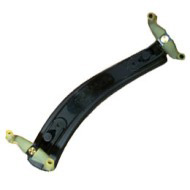|
Principles of Violin Playing (I)
The present series of training articles, “Principles of Violin Playing”, seek to
help students, to appropriately understand this field, by gradually introducing,
categorizing, and teaching the myriad relevant points. One of the principles of
playing violin, which must be always kept in mind, is that the selection of the
most natural position for the body parts while playing is the best and most
appropriate solution. As a matter of fact, any unnatural body part position
which requires lots of energy or unusual stretching to maintain, is wrong.
Practicing the above-mentioned principles eases violin playing and decreases
problems associated with phrases the playing of which is impossible by taking
wrong unnatural positions. Moreover, correcting wrong playing styles makes
playing less exhausting and more fun.
Pattern 1/1
Holding the Violin
Generally while playing violin three parts of the body are involved: chin,
shoulder and the left hand. Each of these parts shoulders a part of the burden
of holding the instrument. However, the player should be able to hold the
instrument with only the neck and the shoulder without using the left hand.
1/1/1- Shoulder and neck:
The player should not raise the left shoulder in order to hold the violin. On
the contrary, his shoulder must remain in its natural position. In case the
player’s neck is long, he may bring up his shoulder or bend his neck both of
which are wrong.
Because for maintaining the former, the player should waste extra energy to
raise his shoulder in vain which not only makes him exhausted but also distract
his attention as he must focus on keeping this position. The latter, puts extra
pressure on
cervical vertebrae and cartilage
as they are stretched more than usual.
Two solutions can be applied to solve this problem. Firstly, the player can fold
a piece of fabric and put it under the violin. As a second solution, however,
the player can buy a shoulder rest. Picking a shoulder rest is very important as
it can play a significant role in making violin playing more comfortable.
The desired type of these shoulder rests are those with double adjustable legs
so that the violinist can attain the most appropriate fit. Moreover, shoulder
rest joints make it possible for the shoulder rest to move so that it would be
flexible and help the violinist keep the instrument in proper place.
An important point to consider in regard to shoulder rests is the design of the
padding and its bending so that the shoulder rest could be placed both on the
shoulder and on the collar bone and the chest. The padding should be covered
with foam or thick-enough sponge-like material. Using shoulder rests which are
not made of foam or those whose material quality is low is not recommended.
Shoulder rests of quality are adjustable in sideways; therefore, they can be
used with violins of variable sizes. This characteristic makes it possible to
change the position of the rest at the back of the violin to make its holding
and controlling easier.
An important advantage of using shoulder rests is that they do not influence the
quality of sound and violin volume. Shoulder rests prevent the volume
transmitted through the lower block of the violin to be taken away by
violinist’s clothing; hence, its pure volume (interestingly enough various
fabrics leave various influences on the volume of the violin. The interested
players might examine this fact.)
1/1/2-How high to raise the left hand:
The violinist should raise his left hand so high that the instrument and its
neck acquire a horizontal position with the ground. It is preferred to hold the
instrument in a way to avoid its being directed downward or upward. In the
former position, the spine bends down because of unnecessary stretch causing
breathing problems and in the latter the
cervical vertebrae are pressurized in the reverse direction.

 
|
تمام حقوق اين
پایگاه اینترنتی متعلق به علی نوربخش میباشد.استفاده از مطالب ویول تنها با ذکر نام سایت مجاز است
Copyright (c) 2011 Viol.ir, ( Ali Nourbakhsh ) all rights
reserved |
| 
